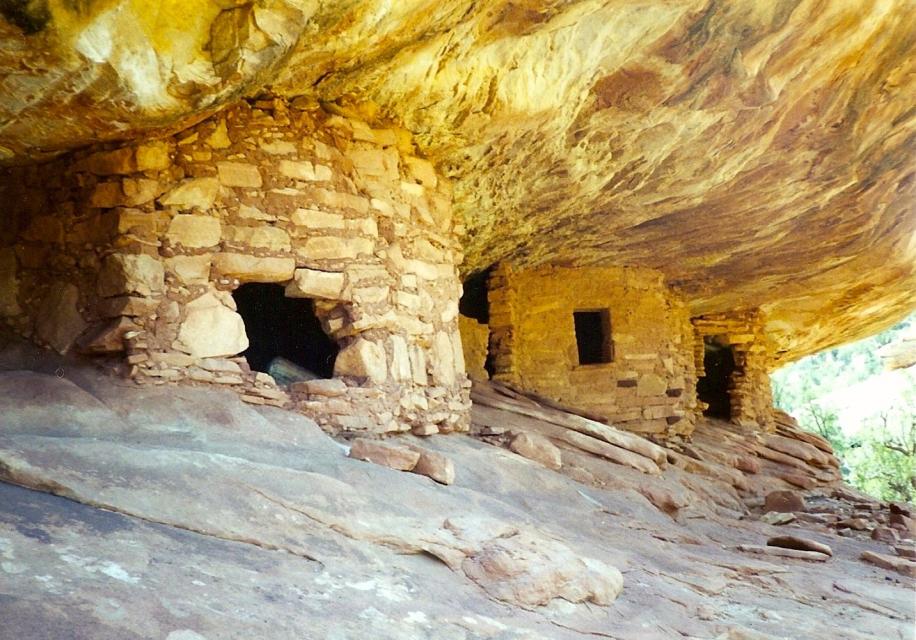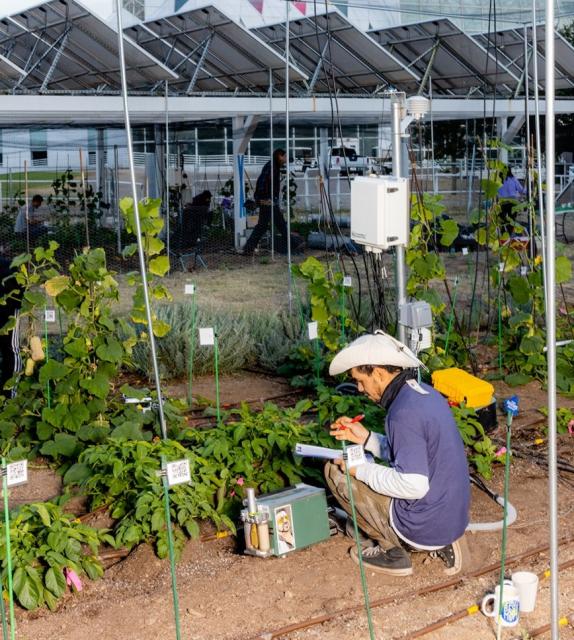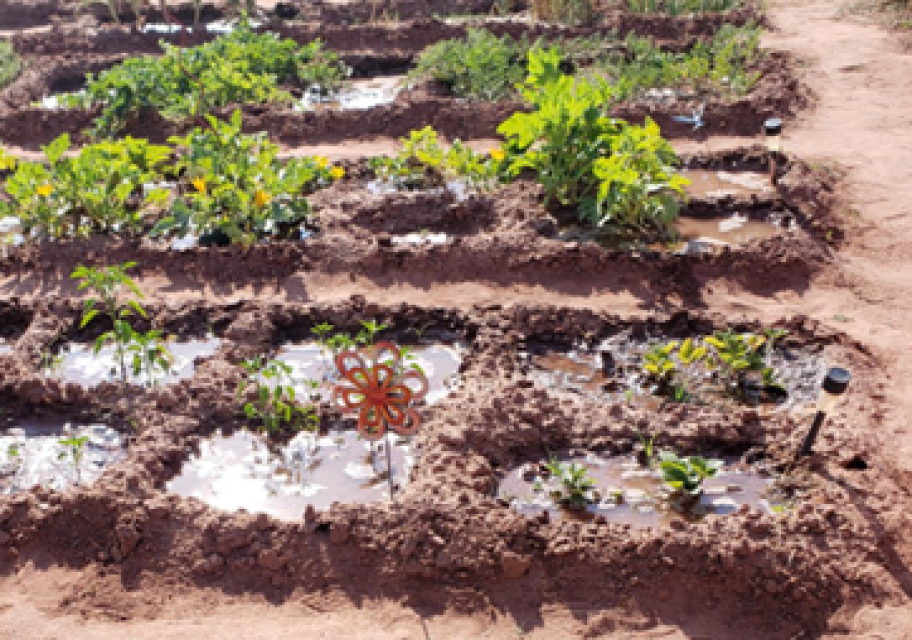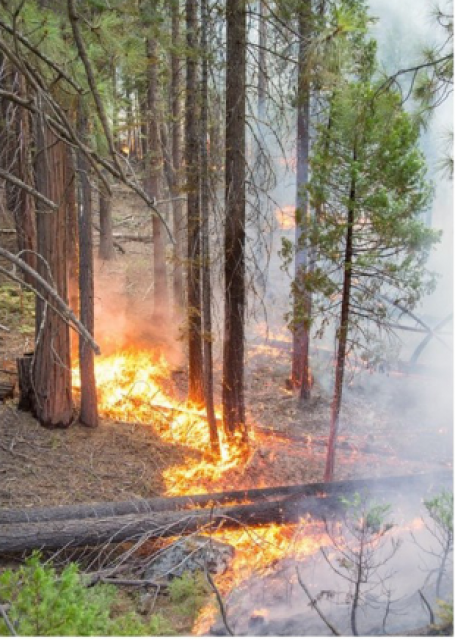Summer 2022 California Project WET Gazette
Volume XXVll, Issue IIl
Water & Traditional Ecological Knowledge in a Changing Climate
‘Tribe follows tribe, and nation follows nation, like the waves of the sea.’
― Chief Seattle
 Years ago, I had the pleasure of exploring the canyon country in the Four Corners region of the Colorado River watershed. I was especially fascinated with the ruins of past civilizations that seemed to be present under every rock overhang and hidden crevice throughout the region. Among the remnants were pictographs and petroglyphs, symbols etched or painted into rock by these past cultures that one can learn about in the Project WET activity ‘Water Messages in Stone’ (Portal).
Years ago, I had the pleasure of exploring the canyon country in the Four Corners region of the Colorado River watershed. I was especially fascinated with the ruins of past civilizations that seemed to be present under every rock overhang and hidden crevice throughout the region. Among the remnants were pictographs and petroglyphs, symbols etched or painted into rock by these past cultures that one can learn about in the Project WET activity ‘Water Messages in Stone’ (Portal).
Newspaper Rock is a stunning example of this artistic record and left me wondering what the symbols reveal about the life of the people in the time periods they were etched – and what warnings they may contain for future civilizations trying to live in the same arid environments. There was plenty of speculation at the time of my travels these sites were abandoned due to factors including declining soil fertility, drought, warfare and a then still budding theory that it may have been all of the above due to changes in climate.
 Research has mounted over the intervening 30 years that naturally occurring oscillations in weather patterns – such as the persistent La Nina weather pattern we are currently experiencing – led to changes in climate that included past megadrought events. These multi-decade extreme weather events identified in tree ring records closely align with the changes observed in the archaeological record of the past twelve centuries.
Research has mounted over the intervening 30 years that naturally occurring oscillations in weather patterns – such as the persistent La Nina weather pattern we are currently experiencing – led to changes in climate that included past megadrought events. These multi-decade extreme weather events identified in tree ring records closely align with the changes observed in the archaeological record of the past twelve centuries.
Despite this history, the descendants of the original human inhabitants are still here. Their ancestors learned how to adapt and survive the changes that led to the abandonment of earlier settlements such as Mesa Verde in the Four Corners area or those of the Hohokam culture in what is now Arizona. They have also survived the arrival of people from Eurasia with diseases unknown to the Americas and their ‘thirst’ for land and natural resources.
The descendants of those Eurasian cultures are finally realizing the traditional knowledge possessed by Native Americans is no longer something to dismiss. In fact, people around the world are realizing indigenous peoples have centuries of knowledge on how to better sustain the environments in which they – and everyone else – live in and depend on for natural resources. And this knowledge is increasingly being integrated into scientific research and validated around the world.
We now find ourselves in the driest 22-year period in the past 1,200 years. A megadrought that evidence indicates would not be as severe were it not being fueled by a rampant increase in greenhouse gases in the atmosphere from the mass burning of fossil fuels in recent centuries. Yet, like those past cultures, we continue to live beyond our available resources with urban water use alone increasing throughout the state since the start of the year.
“We knew it was all going to go to hell, and we just stood by and watched it happen anyway. There ought to be a prize for that kind of stupidity.”
― Paolo Bacigalupi, ‘The Water Knife’
The increase in water use is happening even as news mounts of record low reservoir storage throughout the West, little to no remaining snowpack, increasing drought severity, farmers fallowing hundreds of thousands of acres and a likely increase in summer power outages and fires due to lack of water for crops, the environment or hydropower production. Yet, there is also a growing awareness that indigenous people in the present survived and the traditional ecological knowledge they possess is an invaluable resource. Tribes throughout the West are taking an increasingly active role in using their knowledge to help restore the health and climate resiliency of local ecosystems.
 The Tohono O’odham have farmed in the Sonoran Desert for several thousand years and learned millennia ago to plant under the shade of the mesquite and paloverde trees. Use the Project WET activity ‘Thirsty Plants’ (Portal) to test this in your own backyard this summer by placing bags on plant leaves in full sun and in shade, then observe the differences in transpiration rates. Scientists are marrying this knowledge to high tech by growing crops under solar panel arrays to see if one can get similar crop yields to those grown under the trees while also using less water and producing energy.
The Tohono O’odham have farmed in the Sonoran Desert for several thousand years and learned millennia ago to plant under the shade of the mesquite and paloverde trees. Use the Project WET activity ‘Thirsty Plants’ (Portal) to test this in your own backyard this summer by placing bags on plant leaves in full sun and in shade, then observe the differences in transpiration rates. Scientists are marrying this knowledge to high tech by growing crops under solar panel arrays to see if one can get similar crop yields to those grown under the trees while also using less water and producing energy.
Students notice when comparing activity results that some plants are better water savers than others and that the amount of exposure to sunlight is also a factor in transpiration rates. But so too is choosing plants adapted to the local environment. I doubt the super drought-tolerant blue oaks in my front yard would be a wise planting choice in the native range of mesquite and paloverde trees. This also applies to plants grown for crops. The Tohono O’odham have nurtured a desert-adapted corn that can mature in 60 days and a high-protein bean that folds its leaves to withstand direct sunlight during the peak of summer.
Soil characteristics are also important. Use the ‘Wetland Soils in Living Color’ (p: 217) activity to explore the characteristics of soil in your yard or garden. Sandy soils do not hold onto water as well as those with more silt or clay. Tribes in arid regions noticed long ago that soils under long established trees often have better water-holding characteristics and would add some of this soil to their gardens, similar to what backyard composters do to increase soil water-holding capacity and fertility. Indigenous peoples have done this for millennia too. Remember learning how the Wampanoag taught the Pilgrims to plant corn with fish remains to grow better?
 Instead of raised beds, the Zuni and other Puebloan people sink beds just below ground level and create interior cells of about a square foot enclosed by earthen walls heavy with clay that are designed to hold moisture in the soil. These ‘waffle’ gardens can significantly reduce the amount of water needed for irrigation in backyard gardens. I can’t wait to try this as another water-saving measure in my garden beds. You can try adding this strategy to the practices to consider in the Project WET activity ‘Irrigation Interpretation’ (Portal).
Instead of raised beds, the Zuni and other Puebloan people sink beds just below ground level and create interior cells of about a square foot enclosed by earthen walls heavy with clay that are designed to hold moisture in the soil. These ‘waffle’ gardens can significantly reduce the amount of water needed for irrigation in backyard gardens. I can’t wait to try this as another water-saving measure in my garden beds. You can try adding this strategy to the practices to consider in the Project WET activity ‘Irrigation Interpretation’ (Portal).
Of course, there is an obvious word of caution in applying any kind of knowledge. Too many times we’ve seen something developed in one location applied in places it never should have been – green lawns in a drought-prone arid landscape are one example. Traditional ecological knowledge that can nurture and sustain life in one environment should not be treated as all-encompassing, nor should a practice be assumed as universal to all Indigenous communities.
Europeans were completely baffled by the apparent lack of any agricultural practices in California that at least looked similar to those practiced in Eurasia and by tribes of the southwestern and eastern United States. What the Europeans failed to even try to understand before writing off the intelligence of California tribes is that 1) food resources were quite bountiful throughout much of what is now California and 2) ‘traditional’ agricultural practices are useless when your primary food source is a tree that can take 20 years to bear fruit (acorns), hybridizes with others of its genus like rabbits in springtime and whose planting is completely controlled by millions of squirrels.
 California tribes learned long ago the key to managing and renewing the bounty provided by California oak woodlands, forests, meadows and valleys, wetlands and riparian corridors was fire. As brush built up in prime hunting areas, trees invaded meadows rich in bulbs and other food resources or people could no longer keep up with the growth that hardened supple basket-making plants, the tribes would use fire to reduce the buildup of plant material, stimulating new growth. Let the squirrels and trees take care of creating new oaks – people just need to keep the understory open for ease of hunting and gathering food, basketry and other resources.
California tribes learned long ago the key to managing and renewing the bounty provided by California oak woodlands, forests, meadows and valleys, wetlands and riparian corridors was fire. As brush built up in prime hunting areas, trees invaded meadows rich in bulbs and other food resources or people could no longer keep up with the growth that hardened supple basket-making plants, the tribes would use fire to reduce the buildup of plant material, stimulating new growth. Let the squirrels and trees take care of creating new oaks – people just need to keep the understory open for ease of hunting and gathering food, basketry and other resources.
It is a style of management California tribes are working with the state to bring back on a scale that can make a difference in reducing the destructive intensity of fires we’ve experienced in the past decade, while restoring the function of ecosystems and healthy watersheds protecting water resources throughout the state. Think ‘Color Me a Watershed’ (p: 239) with the human settlement and agriculture re-integrated into the restored natural areas as much as possible.
These are just a few examples of how traditional knowledge is being applied in relation to watersheds and water resources, and you’ll find more examples in the Websites of Interest section of this Gazette. I hope it may inspire you to explore how the traditional knowledge of Indigenous cultures around the world is finally being valued and utilized to restore ecosystems. After all, we are all descendants of tribal cultures if we trace our ancestors back through time. And as a proverb attributed to my Celtic tribal ancestors’ states “Without knowledge of the past we shall lose the future”– though I suspect a version exists in every culture.
It might be worth thinking about the use of water in our own society and the message we may be sending to the future, as the activity ‘Water Messages in Stone’ (Portal) encourages students to do. What symbols or other art might you etch into a rock for future generations to know about us – or maybe to encourage people to conserve more water in the present? Tip: If you do decide to try the activity, an archaeologist showed us how sheets of sandpaper are perfect for simulating etching or painting a rock surface.
It has been another tough year and I hope everyone will be getting a chance for a break before diving into the next school year. Please check-out the variety of upcoming ‘Summer Events’ and ‘Professional Development Opportunities.’ You’ll also find a variety of ‘Grants, Scholarships & Contests’ to kick-off the new school year in late summer through early fall. In the meantime, hope you all have a good summer!
“Humankind has not woven the web of life. We are but one thread within it. Whatever we do to the web, we do to ourselves. All things are bound together. All things connect.”
-- Chief Seattle
WEBSITES OF INTEREST
Article: ’How did past cultures deal with climate change? Mostly, they collapsed.’
Archaeologists are plumbing the human experience to find out how various societies have responded to climate change, shifts in food resources, and natural hazards—among other challenges to human survival. Research findings on three early Native American cultures from the southwestern United States show how each responded to environmental challenges in different ways that dramatically altered their people’s futures.
ARTICLE: ‘What is Traditional Ecological Knowledge?’
Every day of every year for millennia, the indigenous people of California interacted with the native plants and animals that surrounded them. They transformed roots, berries, shoots, bones, shells, and feathers into medicines, meals, bows, and baskets and achieved an intimacy with nature unmatched by the modern-day wilderness guide, trained field botanist, or applied ecologist.
ARTICLE: ‘Native Knowledge: What Ecologists Are Learning from Indigenous People’
From Alaska to Australia, scientists are turning to the knowledge of traditional people for a deeper understanding of the natural world. What they are learning is helping them discover more about everything from melting Arctic ice, to protecting fish stocks, to controlling wildfires.
Article: ’A Return to Native Agriculture’
Indigenous farming and ranching practices are once again being embraced in an American West stressed by drought, diminishing resources, and climate change. Three Native Americans, living in different landscapes and nurtured by different tribal cultures, all share the same goal: to ensure that the traditional Indigenous ways of gathering, growing, husbanding, and serving food are preserved. They are part of a movement, small enough to be barely noticeable in the world of industrial agriculture, but strong enough to be growing steadily, powered by enduring links to Native history and culture.
ARTICLE: ‘Native Americans’ farming practices may help feed a warming world’
Indigenous peoples have known for millennia to plant under the shade of the mesquite and paloverde trees that mark the Sonoran Desert here, shielding their crops from the intense sun and reducing the amount of water needed. The modern-day version of this can be seen in the Santa Catalina Mountains north of Tucson, where a canopy of elevated solar panels helps to protect rows of squash, tomatoes and onions. Even on a November afternoon, with the temperature climbing into the 80s, the air under the panels stays comfortably cool.
ARTICLE: ’The Resurgence of Waffle Gardens Is Helping Indigenous Farmers Grow Food with Less Water’
In the face of climate change and persistent droughts, a growing number of people from Zuni Pueblo in New Mexico and elsewhere are adopting the traditional farming practice. Similar sunken beds for growing food with less water have been used globally in arid regions, arising independently by Indigenous farmers, including across distinct Pueblo tribes in the Southwest.
ARTICLE: ‘Could “Lost Crops” Help Us Adapt to Climate Change?’
Could the archaeological record help provide new perspectives on agricultural resilience, crop diversity, and sustainability in the face of climate change? Archaeologists studying past agricultural practices are looking for lessons on how people have bolstered their food systems against past instances of climate change. They are also exploring the cultivation of ancient crops—the enduring veterans of past climate challenges—as resilient options to diversify our food sources.
Indigenous Fire Practices Shape our Land
For many millenia, fire was integral to many Indigenous peoples’ way of life. Native Americans, Alaska Natives, and Native Hawaiians used fire to clear areas for crops and travel, to manage the land for specific species of both plants and animals, to hunt game, and for many other important uses. Fire was a tool that promoted ecological diversity and reduced the risk of catastrophic wildfires.
California is calling upon Native American tribes to bring back the once-prohibited practice of lighting controlled burns to help prevent devastating wildfires that have wreaked havoc on the state. Indigenous communities across the world have used fires for thousands of years to clear land of extra debris. These burns — less intense than wildfires — lessen the impact on the insects and animals occupying the land. They also protect trees and the canopy.
ARTICLE: ‘The California Indigenous Peoples Using Fire for Agroforestry’
Prescribed burning is the main tool in the Karuk and Yoruk tribes’ agroforestry systems, which encourages proliferation of traditional foods, herbs, and medicines. An ancient technology developed through time by the Karuk tribe and indigenous people around the world, agroforestry integrates crops and livestock into the grasses, shrubs, and trees of native forests.
ARTICLE: ‘How the Indigenous Practice of ‘good fire’ can help our forests thrive’
Two hundred years ago, someone walking through Yosemite would not have seen the densely packed forests we now associate with the Sierra Nevada. They would have passed through broad meadows and perhaps have even been drawn to comment, as the Spanish did, on how the land appeared like a “well-tended garden.” In fact, that is exactly what Spaniards were seeing: Indigenous people native to Yosemite and other parts of the world for millennia have used fire to promote healthy forests.
ARTICLE: ‘Alaska tribal wisdom helps scientists track permafrost changes’
Along with her fellow researchers, USGS researcher Nicole Herman-Mercer has used Alaska Natives’ monitoring of wild berry crops to track what’s going on with the underlying permafrost. The researchers learned that the abundance and fruiting cycles of the berries, and where they were found, were changing along with the warmer temperatures affecting the permafrost.
ARTICLE: ‘An ancient people with a modern climate plan’
For 10,000 years, the Swinomish tribe has fished the waters of northwestern Washington, relying on the bounty of salmon and shellfish not only as a staple of its diet but as a centerpiece of its culture. At the beginning of the fishing season, the tribe gathers on the beach for a First Salmon ceremony, a feast honoring the return of the migratory fish that binds the generations of a tribe that calls itself the People of the Salmon.
Much of the western U.S. has been in the grip of an unrelenting drought since early 2020. The dryness has coincided with record-breaking wildfires, intense and long-lasting heat waves, low stream flows and dwindling water supplies in reservoirs that millions of people across the region rely on. Heading into summer, the outlook is pretty grim.
Article: ‘The West without Water: What Can Past Droughts Tell Us About Tomorrow?
Almost as soon as European settlers arrived in California they began advertising the place as the American Garden of Eden. And just as quickly people realized it was a garden with a very precarious water supply. Currently, California is in the middle of a years-long drought and the water crisis is threatening the region’s vital agricultural economy, not to mention the quality of life of its people, plants, and animals.
Article: ‘La Niña responsible for megadroughts in North and South America, study finds’
Over the past millennium nine megadroughts occurred in the North American Southwest. The researchers found that seven of these events happened simultaneously in both North America and South America due to the colder eastern Pacific surface water temperatures brought about by La Niña. “The co-occurrence of these events cannot be explained by chance,” the researchers stated in the study.
This Water Education Foundation page is where you can find real-time reservoir levels, drought severity maps, special reports, a newsfeed of current developments and general background on droughts in California and the West, as well as answers to common drought questions and tips for how you can save water at home.
Californians have made great progress in recent years embracing wise water use as a daily habit. But our lawns have a drinking problem. About 50% of water is used for outdoor irrigation. Transforming a lawn with drought-resistant California native plants is easy, will save you money, and is more critical than ever to help California move toward a more sustainable and secure future.
PROFESSIONAL DEVELOPMENT OPPORTUNITIES
Forestry Institute for Teachers
Enjoy a week with natural resource professionals and advocates gaining a deeper understanding of forest ecosystems and human use of natural resources. Participants receive a high-quality professional development experience focused on interdisciplinary content and practices at the heart of current forest issues – as well as Common Core and Next Generation Science Standards. You’ll leave with a wealth of environmental education curriculum- including Project Learning Tree and Project WET. Summer 2022 Registration is closed for but look for 2023 session dates early in the new year.
California Water Institutes for Teachers
These multi-day professional development experiences for K-12 teachers focus on the water infrastructure and supply that serve the local area of each institute, while providing teachers with greater depth of knowledge and tools to engage students in learning about their local watersheds and development of their environmental literacy about the places where they live and recreate. Participants will also receive Project WET training, be able to earn continuing education credit and an opportunity to receive a $250 stipend. Registration is still open for the Solano Water Institute!
Understanding Climate Change in California Workshops
These specialized Project WET workshops provide an opportunity for educators to interact with climate experts for a day of learning about the basics of weather and climate science, how the California Department of Water Resources and other organizations are applying this science to safeguard California water resources – and how Project WET activities can help you integrate climate science concepts and skills back in the classroom – Join us in western Merced County this summer!
California Project Learning Tree Workshops
Project Learning Tree uses trees and forests as windows on the world to increase students’ understanding of the environment and actions they can take to conserve it. UC Cooperative Extension hosts the program in California to deliver regular workshops for educators interested in using trees and forests as windows to the world. Trainings are offered to schools, teachers, parents, students and other non-profit organizations for outdoor environmental education programs.
California Environmental Education Interagency Network (CEEIN)
The California Environmental Education Interagency Network (CEEIN) is a consortium of environmental educators representing state departments and partner organizations. The CEEIN partnership maintains an online calendar, where educators can find a variety of workshop experiences, participatory stewardship opportunities and valuable ways to increase their own knowledge and environmental literacy offered by California agencies and their partnership network.
SUMMER EVENTS
July 2 and September 3, 2022: California Free Fishing Days
Free Fishing Days provide a great, low-cost way to give fishing a try. Some CDFW Regions offer a Fishing in the City program and free fishing day clinics designed to educate novice anglers about fishing and where you can go fishing in the major metropolitan areas. You can even learn how to clean and prepare your catch so you can enjoy it for dinner that night!
August 25, 2022 - Free Entrance Days in the National Parks
Mark your calendar to celebrate the National Park Service’s 106th birthday! National parks across the country will be hosting in-park programs and virtual experiences. Entrance fees are also waived to encourage everyone to come out to enjoy their national parks
September 1 – 30, 2022 – National Preparedness Month
Every year, the United States observes National Preparedness Month in September to remind Americans to be ready for any disaster — man-made or natural — that could affect them, their homes, communities, or businesses. This month aims to reduce the fallout of large-scale emergencies by preparing every citizen, young and old.
September 17, 2022 - California Coastal Cleanup Day
Join the fight to help clean the beach by picking up litter in your community. As Covid restrictions have lifted across the state, many local organizers will be returning to in-person cleanups. Plan to spend a day outside connecting with your community to celebrate California! Click here for more information on how you and your students can participate!
September 22-24, 2022 - California Agriculture in the Classroom Conference
We are so excited to be (finally) hosting an in-person conference in Ventura County! You won’t want to miss this opportunity to collaborate with educators who share your passion for agriculture! The conference is designed for K-12 educators, administrators, and volunteers to come together to learn and share how to incorporate food and fiber into all curricular areas. More details and registration information coming soon!
September 24, 2022 – National Public Lands Day
During the height of the COVID-19 pandemic, America’s public lands acted as a safe haven for recreation, conversation, and the simple enjoyment of being outside the confines of our homes. In a time of disconnection and uncertainty, the outdoors brought together people from all walks of life and deepened our appreciation for the important role these spaces play in our lives. Now it’s time for us to return the favor!
September 24, 2022 - Free Entrance Days in the National Parks
Help care for your national parks by volunteering during a one-time event or on a reoccurring basis. National Public Lands Day is traditionally the nation’s largest single-day volunteer effort. It celebrates the connection between people and green space in their community, sparks stewardship of our environment, and encourages use of open space for education, recreation, and health benefits.
GRANTS, SCHOLARSHIPS & CONTESTS
Forestry Challenge – Register Open: Fall 2022
The Forestry Challenge is an academic event for high school students in technical forestry and current forestry topics. Participants spend four days in the forest learning about the ecology and management of the forested landscapes that provide communities with water, recreational opportunities, wood products, and wildlife habitat. Pre-Registration for 2022 Fall Forestry Challenge events is now open! Thanks to new Grant Funding, Registration is now FREE!
Philanthropic Ventures Foundation Teacher Grants
Teachers come up with good ideas all the time, but don’t have the resources to fund them or the time to pursue arduous funding requirements. That’s why we launched Teacher Resource Grants. These small but critically needed grants for teachers help to address inequalities in public education and build future generations of strong leaders.
“Let’s Go!” Field Trip Fund
Through the “Let’s Go!” Field Trip Fund, the Environmental Volunteers provides affordable, easy-to-schedule, efficient and safe transportation for low-income youth (K-12) in the San Francisco Bay Area (Alameda, Contra Costa, Marin, Napa, San Francisco, San Mateo, Santa Clara, Solano, or Sonoma) that facilitates access to science and environmental education field trips.
California Ocean and Coastal Amateur Photography Contest – Contest Opens: August 1, 2022
The contest is free and open to all amateur photographers. An amateur photographer is defined as someone who earns less than 50 percent of their income from photography. Photographs in this contest feature the following subjects: The scenic coast and Pacific Ocean off California, People and the California coast, and California ocean and coastal wildlife.
WHALE TAIL® Grants - Grants will open in September 2022
WHALE TAIL® grants support experiential education and stewardship of the California coast and its watersheds. Projects must relate to the coast and ocean. We strongly encourage projects that engage communities that have historically received fewer opportunities for coastal and marine education and stewardship, and applicant organizations based in the communities they are engaging.
Toshiba America Foundation K – 5 Grant - Deadline: October 1, 2022
Do you have an innovative idea for improving STEM learning in your classroom? Is your idea project-based learning with measurable outcomes? What do you need to make learning math and science fun for your students? K-5 grade teachers are invited to apply on-line for a $1,000 Toshiba America Foundation grant to help bring an innovative hands-on project into their own classroom.
Toshiba America Foundation 6 - 12 Grant - Deadline: November 1, 2022
Do you teach in a middle and high school classroom and have an innovative idea for improving STEM (Science, technology, engineering and math) learning in your classroom? Sixth to 12th grade teachers are invited to apply on-line for a Toshiba America Foundation grant of up to $5,000 and more than $5,000 to help bring an innovative project into their own classroom.
CREDITS
California Project WET Gazette is published by the Water Education Foundation, which serves as the state coordinator and host institution for Project WET USA, a program of the Project WET Foundation.
This material is based upon work supported by the U.S. Geological Survey under Grant/Cooperative Agreement No. G21AC10429. The views and conclusions contained in this document are those of the authors and should not be interpreted as representing the opinions or policies of the U.S. Geological Survey. Mention of trade names or commercial products does not constitute their endorsement by the U.S. Geological Survey.
Editor: Brian Brown, California Project WET Coordinator
Water Education Foundation
2151 River Plaza Dr., Suite 205
Sacramento, CA 95833
916.444.6240
email: projectwet@watereducation.org









